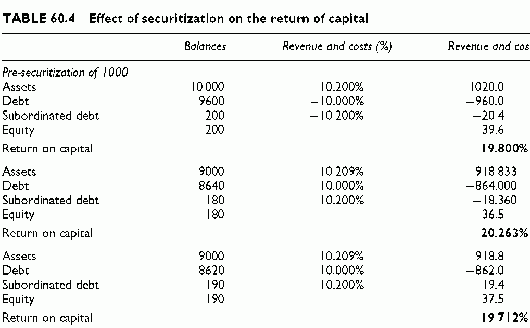ENHANCING RETURN ON CAPITAL THROUGH SECURITIZATION
Category: Risk Management in Banking
Under a forfeit valuation of capital as a function of the amount securitized, it is relatively easy to determine whether the securitization enhances the ROE, by how much, and what are the limitations. Under full economic capital analysis, the capital results from a direct calculation with a portfolio model pre- and post-securitization. The enhancement issue consists of finding out whether the securitization enhances the risk-return profile of the banks portfolio, and more practically, whether the post-securitization RaRoC is higher or lower than the pre-securitization RaRoC. We address both issues sequentially. The next subsection details the effect on the return on capital of the securitization.
The Effect of Securitization on the Return on Capital
Table 60.4 shows the income statement pre- and post-securitization. The debt, the subordinated debt and the equity represent the same percentages of total assets, respectively 96%, 2% and 2%. Their costs are identical to above. Pre-securitization, assets yield 10.200%. Post-securitization, we found above that the assets yield more, or 10.2093%. The gain influences directly the return on capital, which increases from 19.800% to 20.263%.
In general, the effect of an increase of asset yield on capital return is not mechanical because the capital gain is the marginal risk contribution of the subportfolio securitized. Therefore an increase of asset yield due to a capital gain from sale to the SPV might not increase the return on capital if the capital saving is lower. For instance, if the capital decreases only to 190, and subordinated debt does also, the remaining debt being the complement to 9000 or 9620, the same calculations would show that the new return on capital becomes 37.5/190 = 19.712%. This is a lower value than the original 19.800%. It is necessary to determine the economic capital pre- and post-securitization, both to determine the magnitude of the capital savings and to perform return calculations on new capital post-securitization. Once economic capital is determined and converted into a percentage of assets, we are back to the same type of formula as above.
The Leverage Effect on ROE of Securitization
If securitization improves the ROE, it is tempting to increase the amount securitized. The bank would benefit even more from the positive relationship between the amount securitized and the ROE. This is the leverage effect of securitization. Leverage is positive as long as the cost of funding through securitization remains fixed at the 10.08% obtained above. If we consider this figure as given, the higher the amount securitized, the higher the final ROE after securitization.
For instance, using the above example, securitizing 2000 instead of 1000, and keeping the same proportions of assets for debts and capital, would mechanically increase the ROE. This increase does not result from an additional capital gain in percentage of assets securitized, since this gain remains 0.833% of assets (one-shot). Rather it results from the fact that the additional annualized yield is proportional to the ratio of assets pre- and post-securitization. In the example, with 1000 securitized, the additional annualized yield in percentage of assets post-securization is 0.0833% x 1000/9000 = 0.00926% of assets. Should we sell 2000, the same percentage of assets post-securitization would increase
to 0.0833% x 2000/9000 = 0.02082%, the EBT would become 33.346 and the return
on capital (now 160) would be 33.346/160 = 20.841%. Another quick simulation would show that securitizing 5000 out of 10,000 would provide an EBT of 23.965 and a return on capital of 23.965%. In fact securitizing 5553 would allow hitting the 25% target return on remaining assets. This is the leverage effect of securitization, which is more than proportional to the amount securitized.
However, there are limits to the leverage effect. First, a bank securitizing all assets changes its business. It becomes a pure originator reselling new business to outside investors. Origination and lending, collecting deposits and providing financial services to customers, are the core businesses of commercial banking. Keeping loans on-balance sheet is part of the core business. This is a first reason for not going all the way to securitizing the entire balance sheet. Second, the originators need to replenish the pool of securitized receivables. In order to do so, they need to keep assets on-balance sheet. This happens when securitizing credit cards that amortize much quicker than mortgages. In such cases, the pool of credit card receivables rolls over with time and fluctuates depending on the customers behaviour. The bank needs a pool of credit card receivables to replenish the pool of securitized assets. Third, increasing securitization significantly would result in a significant change in business and might change the investors perception of the seller, modifying his cost of funds. This is not necessarily true, however, depending on the usage of capital savings.

